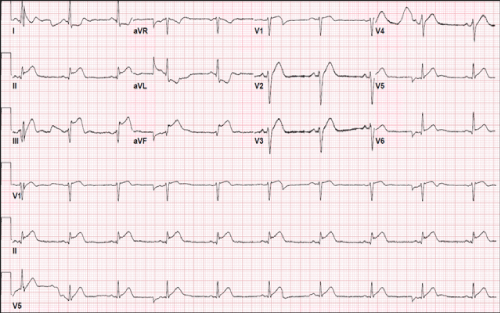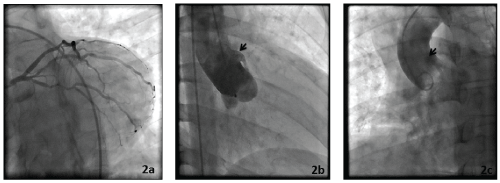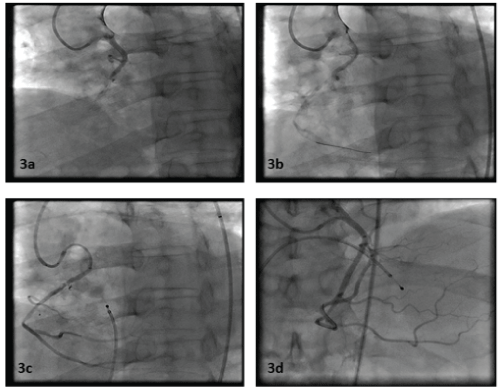International Journal of Clinical Cardiology
Anomalous Right Coronary Artery Arising from the Ascending Aorta Above the Left Sinus of Valsalva in the Setting of Acute Inferior ST-Elevation Myocardial Infarction: Unique Challenges and Literature Review
Nisharahmed Kherada*, Sandeep Singla, Saqib Ali Gowani, Francesca Gallarello and Nirat Beohar
Division of Cardiology at the Mount Sinai medical Center, Columbia University, USA
*Corresponding author: Nisharahmed Kherada, Mount Sinai medical Center, Department of Cardiology, Columbia University, 4300 Alton Rd, Miami Beach, Suite 2070, FL 33140. USA, Tel: 305-535-7914, Fax: 305-674-2165, E-mail: kherada.1@gmail.com
Int J Clin Cardiol, IJCC-2-031, (Volume 2, Issue 3), Case Report; ISSN: 2378-2951
Received: March 12, 2015 | Accepted: April 29, 2015 | Published: May 02, 2015
Citation: Kherada N, Singla SA, Gowani S, Gallarello F, Beohar N (2015) Anomalous Right Coronary Artery Arising from the Ascending Aorta Above the Left Sinus of Valsalva in the Setting of Acute Inferior ST-Elevation Myocardial Infarction: Unique Challenges and Literature Review. Int J Clin Cardiol 2:031. 10.23937/2378-2951/1410031
Copyright: © 2015 Kherada NA, et al. This is an open-access article distributed under the terms of the Creative Commons Attribution License, which permits unrestricted use, distribution, and reproduction in any medium, provided the original author and source are credited.
Abstract
Anomalous origin of the right coronary artery arising from ascending aorta above the left sinus of Valsalva is an extremely rare coronary anomaly. In the setting of an acute myocardial infarction rapid identification, localization and selective cannulation of this 'culprit' anomalous right coronary artery presents a challenging scenario. Here we describe a case with this anomaly presenting as an acute inferior wall myocardial infarction along with description of its distinctive interventional challenges. We also provide a comprehensive review of all the cases with this anomaly described in the English Literature.
Keywords
Coronary anomalies, Ascending aorta, Myocardial infarction, Percutaneous coronary intervention, Sinus of valsalva, Guidewire, Guideliner
Introduction
The incidence of coronary artery anomalies (CAAs) ranges from 0.1% to 8.4% depending on the angiographic, autopsy and echocardiographic studies [1]. In one large angiographic series of 126,595 consecutive cases, the right coronary artery (RCA) arose anomalously from the left cusp in 0.10% cases and had a high ascending aortic origin (above the right cusp) in 0.15% [2]. A combination of leftward and high origin of RCA with ostium in the ascending aorta above the left sinus of Valsalva (LSOV) is a very rarely described entity with only 16 cases reported so far in the English literature and among these only 2 cases were in the setting of myocardial infarction (MI) (Table 1). Here, we describe a case with this anomaly who presented as acute inferior wall ST-elevation MI and underwent emergent primary percutaneous coronary intervention (PCI). In addition we provide a comprehensive review of literature on this anomaly.
![]()
Table 1: Baseline and angiographic characteristics in previous 16 cases with anomalous RCA arising from the ascending aorta above the left sinus of Valsalva
View Table 1
Index case
The patient was 59 years old male with history of hypertension and dyslipidemia who presented with intermittent left arm and shoulder heaviness associated with shortness of breathe for the past three days. At presentation he was hemodynamically stable and an electrocardiogram showed inferior injury pattern with reciprocal changes (Figure 1). Troponin-I was elevated at 1.15ng/ml. He underwent an emergent coronary arteriography via femoral approach. Selective left coronary artery injection showed mild luminal irregularities in left anterior descending (LAD) artery and a focal 50% lesion in the left circumflex (LCx) coronary artery (Figure 2a). On multiple attempts with JR-4 (Judkins right, size 4), 3DRC (3 dimensional right coronary), AR-1 (Amplatz right) and AL-1 (Amplatz left) catheters the ostium of the RCA could not be cannulated. A cusp angiogram did not show any artery arising from the right cusp. Suspecting an anomalous origin of the RCA, left anterior oblique (LAO) and right anterior oblique (RAO) aortic root angiograms were performed using pig tail catheter and an anomalous origin of RCA about 2cm above the LSOV with an anterior course and Thrombolysis In Myocardial Infarction (TIMI) 1 flow was visualized. (Figures 2b,2c). Despite multiple attempts with JR-4, IM (internal mammary), MP (multipurpose), AL-1 and AL-2 and AR-1 guide catheters, we were unable to selectively cannulate the aberrant vessel.

.
Figure 1: Electrocardiogram on presentation. Normal sinus rhythm, regular 60 bpm, ST-segment elevation in leads II, III, aVF; ST depression in leads I, aVL.
View Figure 1

.
Figures 2a-c: 2a) Left coronary angiogram and aortogram. Initial selective left coronary artery injection; 2b) Left anterior oblique; 2c) and right anterior oblique aortogram revealing origin of the anomalous right coronary artery (arrow) from the ascending aorta above the left sinus of Valsalva.
View Figures 2a-c
We then decided to use a LCB (Left coronary bypass) guide on the premise that the origin of the RCA matches with the take-off of a left sided graft. This guide gave us a position very close to anomalous orifice and with semi-selective injection of contrast we had clearer view of the anomalous origin (Figure 3a). Then we took a short 0.014 BMW (Balance Middle Weight, Abbott Vascular, USA) wire and were able to advance it into the anomalous vessel (Figure 3b). The guide would still not slide over the wire to give us a stable position. We then advanced a 6 F Guideliner (Vascular Solutions, USA) through the LCB guide into the ostium of the RCA without any dampening. We noticed the anterior course of this anomalous RCA with subtotal occlusion in its proximal-mid segment. This segment was pre-dilated with a Sprinter 2.5 x 15mm balloon at 14 atm for 10 seconds. (Figure 3c). During this time, the patient developed severe bradycardia requiring the placement of a 5-French temporary pacemaker through the right femoral vein. Following that we deployed a drug eluting 2.75 x 30mm Resolute integrity stent(Medtronic Cardiovascular, Santa Rosa, CA, USA) at 15 atm for 20 sec with excellent angiographic results (Figure 3d). Brisk TIMI 3 flow was restored without any evidence of edge dissection or distal embolization. After completion of the procedure, temporary pacemaker was removed and adequate hemostasis was achieved using an Angio-Seal (St. Jude Medical, St. Paul, MN) for arteriotomy and manual compression for the venous access. Post PCI the patient had echocardiogram with left ventricular ejection fraction of 55% with infero-septal hypokinesia. He had uneventful hospital course over the next 48 hours, and was discharged in stable condition on appropriate medical regimen.

.
Figures 3a-d: Percutaneous angioplasty of anomalous right coronary artery.
3a) Semi-selective injection of contrast closer to the anomalous origin with use of left coronary bypass guide catheter; 3b) Short 0.014 balance middle weight wire threaded into the anomalous vessel; 3c) First inflation of Sprinter balloon at prox-mid RCA; 3d) Final angiographic result after drug-eluting stent DES deployment.
View Figures 3a-d
Discussion
The overall prevalence of an anomalous RCA is about 0.2% in the angiographic studies, and about 0.15% prevalence of RCA originating anomalously from the ascending aorta [2,15]. Among the high anomalous origin, RCA most commonly arise from above the right sinus of Valsalva [2], and occasional reports describe origin above the non-coronary sinus [16-18]. Anomalous origin of the RCA from the ascending aorta above the LSOV was first described in 1978 by Yans et al. [3]. Since then only 16 cases have been described with this very rare coronary anomaly, and among those only two cases had presented with an acute MI. Our case is only the third case in the literature with successful PCI of anomalous RCA in this unique setting. Angiographically it is challenging to engage this anomalous RCA due to lack of good point of wall support [12], slit like orifice due to initial intra-aortic course and different than normal angulation [14,19,20]. In our case, after semi selective contrast injection into the ascending aorta and localizing the anomalous RCA, we used the rail provided by the 0.014 BMW guide wire and a guideliner. This gave enough support and alignment for the selective engagement of this rare anomalous RCA with the LCB guide catheter that helped us to intervene on culprit mid-RCA lesion in the setting of acute MI with excellent angiographic result.
Clinically, anomalous RCA from left coronary cusp has shown to be associated with the sequelae like angina pectoris, MI, ventricular tachycardia, syncope, and sudden death in the absence of coronary atherosclerosis [13,21,22]. In our review of anomalous RCA from above the LSOV, 10 patients presented with chest pain, 2 patients with acute MI, 1 with unstable angina and 3 presented for elective PCI [congenital AS (2 cases), known coronary artery disease (CAD) (1 case)]. No patient was identified with ventricular tachycardia, syncope or sudden cardiac death upon presentation. Anatomically, the reported high take off of the anomalous RCA from the ascending aorta above the left sinotubular junction has varied from 1-4cm. We found it about 2cm above the left sinotubular junction in our case. Invariably, this aberrant RCA has an anterior course traversing between the pulmonary artery and aorta. Systolic compression of the aberrant artery at the proximal course between the great vessels [23], and the high take off with lateral displacement making the kinking of the vessel may explain the accelerated atherosclerotic process in the early portion of these anomalous vessels [24,25]. This was consistent with the finding of thrombotic 99% occlusion in the proximal-mid segment of anomalous RCA in our case as seen in previous two cases in the literature who presented with an acute MI.
In summary, our case adds on to the small series of cases with this very rare RCA anomaly and especially for the presentation of acute MI. Proximal-mid territory of the lesions in all the three cases of acute MI presentation raise the importance of pathophysiological mechanisms associated with anterior inter- arterial course. Similar to others, but perhaps more difficult was getting a selective engagement of the ostium in this case. Despite using an array of the available guide catheters (JR 4, 3DRC, AL 1, IM, MP, AR 1 and extra back-up (EBU) 3.5) we could not selectively engage the anomalous RCA ostium. In our case the rail provided by 0.014 guidewire and guideliner provided the necessary support for getting a selective engagement with the LCB guide catheter. As in other 2 cases of acute MI presentation we also achieved excellent angiographic result with primary PCI.
Based on our case experience and review of literature we recommend the following
1) When anomalous origin is suspected cine angiography of aortic root in LAO and RAO projection should be considered. This is especially true in urgent/emergent situations where patient presents with acute MI. In more elective situations MDCT may be considered to delineate the origin and course of the anomaly [14].
2) It is hard to make a definitive recommendation for any particular guide catheter but as per our experience, it is advised to start with AL1, AL2, and MP guide and followed by left coronary bypass guide catheters. If reach is not enough then consider wiring from the distance following advancement of the guideliner as used in this case.
References
-
Barriales-Villa R, Moris de la Tassa C (2006) Congenital coronary artery anomalies with origin in the contralateral sinus of Valsalva: which approach should we take?. Rev Esp Cardiol 59: 360-370.
-
Yamanaka O Hobbs RE (1990) Coronary artery anomalies in 126,595 patients undergoing coronary arteriography. Cathet Cardiovasc Diagn 21: 28-40.
-
Yans J, Kumar SP, Kwatra M (1978) Anomalous origin of the right coronary artery above the left sinus of Valsalva. Cathet Cardiovasc Diagn 4: 407-412.
-
King BD, Ambrose JA, Stein JH, Ro JH, Herman MV (1982) Anomalous origin of the right coronary artery from the ascending aorta above the left coronary sinus. Cathet Cardiovasc Diagn 8: 277-280.
-
Palomo AR, Schrager BR, Chahine RA (1985) Anomalous origin of the right coronary artery from the ascending aorta high above the left posterior sinus of Valsalva of a bicuspid aortic valve. Am Heart J 109: 902-904.
-
Partridge JB (1986) High leftward origin of the right coronary artery. Int J Cardiol 13: 83-88.
-
Thatcher JL Miller WP (1988) Anomalous origin of the right coronary high above the left sinus of Valsalva. Cathet Cardiovasc Diagn 15: 187-188.
-
Rovani X Relland J, Gaux JC (1990) Anomalous origin of the right coronary artery from the ascending aorta. Cathet Cardiovasc Diagn 20: 136-138.
-
Goldstein PR Pittman DE, Gay TC, Brandt CS (1990) Anomalous origin of the right coronary artery from the ascending aorta: case history. Angiology 41: 164-166.
-
Chadow H Kwan T, Huber M, Feit A (1994) Anomalous origin of the right coronary artery above the left posterior sinus of Valsalva associated with a normal aortic valve. A case history. Angiology 45: 963-966.
-
Ayalp R, Mavi A, Serçelik A, Batyraliev T, Gümüsburun E (2002) Frequency in the anomalous origin of the right coronary artery with angiography in a Turkish population. Int J Cardiol 82: 253-257.
-
Ceyhan C, Tekten T, Onbasili AO (2004) Primary percutaneous coronary intervention of anomalous origin of right coronary artery above the left sinus of Valsalva in a case with acute myocardial infarction. Coronary anomalies and myocardial infarction. Int J Cardiovasc Imaging 20: 293-7.
-
Lee JJ Kim DH, Byun SS, Choi WG, Lee CW, et al. (2009) A case of acute myocardial infarction with the anomalous origin of the right coronary artery from the ascending aorta above the left sinus of Valsalva and left coronary artery from the posterior sinus of Valsalva. Yonsei Med J 50: 164-168.
-
Jin SA Seong SW, Kim SS, Lee YD, Choi UL, et al. (2012) Successful percutaneous coronary intervention in an anomalous origin of the right coronary artery from the ascending aorta above the left sinus of the valsalva. Korean Circ J 42: 497-500.
-
Ho JS Strickman NE (2002) Anomalous origin of the right coronary artery from the left coronary sinus: case report and literature review. Tex Heart Inst J 29: 37-39.
-
Ilia R Abu-Ful A, Gueron M (1994) Anomalous origin of the right coronary artery from the ascending aorta above the noncoronary sinus of Valsalva. Cathet Cardiovasc Diagn 32: 257-258.
-
Ilia R (1995) Anomalous origin of the right coronary artery high above the noncoronary sinus of valsalva. Cathet Cardiovasc Diagn 35: 184-185.
-
Ng W Chow WH (2000) Successful angioplasty and stenting of anomalous right coronary artery using a 6 French Left Judkins #5 guide catheter. J Invasive Cardiol 12: 373-375.
-
Maresi EA Argo AM, Spanò GP, Novo GM, Cabibi DR, et al. (2006) Images in cardiovascular medicine. Anomalous origin and course of the right coronary artery. Circulation 114: e609-611.
-
Taylor AJ Rogan KM, Virmani R (1992) Sudden cardiac death associated with isolated congenital coronary artery anomalies. J Am Coll Cardiol 20: 640-647.
-
Bett JH, O'Brien MF, Murray PJ (1985) Surgery for anomalous origin of the right coronary artery. Br Heart J 53: 459-461.
-
Kragel AH, Roberts WC (1988) Anomalous origin of either the right or left main coronary artery from the aorta with subsequent coursing between aorta and pulmonary trunk: analysis of 32 necropsy cases. Am J Cardiol 62: 771-777.
-
Grollman JH Jr, Mao SS, Weinstein SR (1992) Arteriographic demonstration of both kinking at the origin and compression between the great vessels of an anomalous right coronary artery arising in common with a left coronary artery from above the left sinus of Valsalva. Cathet Cardiovasc Diagn 25: 46-51.
-
Frescura C, Basso C, Thiene G, Corrado D, Pennelli T, Angelini A, et al. (1998) Anomalous origin of coronary arteries and risk of sudden death: a study based on an autopsy population of congenital heart disease. Hum Pathol 29: 689-695.
-
Hutchins GM, Miner MM, Boitnott JK (1976) Vessel caliber and branch-angle of human coronary artery branch-points. Circ Res 38: 572-576.





